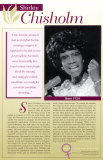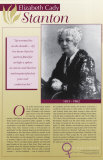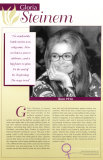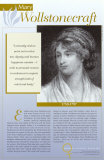|
Pioneers of Women's Rights Movement Educational Posters
for the social studies classroom, home schoolers and theme decor.
|
social studies > Pioneers of Women’s Rights Movement Poster | women activists < famous women alphabetical list
|
|
“Pioneers of Women’s Rights Movement” poster series celebrate Susan B. Anthony, Shirley Chisholm, Elizabeth Cady Stanton, Gloria Steinem, Sojourner Truth. See page 2 for more women who chimed in for women's rights: Abigail Adams, Louisa May Alcott, Lady Astor, Margaret Fuller, Anne Hutchinson, Lucretia Mott, the Pankhursts, Mary Wollstonecraft and Victoria Woodhull.
|
Women's Equality Day
Designating August 26th of each year as Women's Equality Day
WHEREAS, the women of the United States have been treated as second-class citizens and have not been entitled the full rights and privileges, public or private, legal or institutional, which are available to male citizens of the United States; and
WHEREAS, the women of the United States have united to assure that these rights and privileges are available to all citizens equally regardless of sex; and
WHEREAS, the women of the United States have designated August 26th, the anniversary date of the passage of the Nineteenth Amendment, as symbol of the continued fight for equal rights: and
WHEREAS, the women of United States are to be commended and supported in their organizations and activities,
NOW, THEREFORE, BE IT RESOLVED, the Senate and House of Representatives of the United States of America in Congress assembled, that August 26th of each year is designated as "Women's Equality Day," and the President is authorized and requested to issue a proclamation annually in commemoration of that day in 1920, on which the women of America were first given the right to vote, and that day in 1970, on which a nationwide demonstration for women's rights took place.
|
|
|
Susan B. Anthony
b. 2-15-1820; Adams, MA;
d. 3-13-1906
“That society is wrong which looks on labor as being any more degrading to women than to men.”
Susan Brownell Anthony was one of the most important organizers of the early women's rights movement. As a young woman in the 1840s, she worked as a teacher. She grew angry when she realized that she was paid less than one-fourth of what her male coworkers were. This anger fueled her interest in women's labor issues. Soon Anthony learned that this was not the only area in which women were treated unfairly. In 1851 she met Elizabeth Cady Stanton, another vocal supporter of women's rights. and the two became powerful allies and close friends. The two women often worked together. Their main focus was on the fight for women's suffrage, to women's right to vote. In 1869, they formed the National Woman Suffrage Association. From 1868 to 1870 they published The Revolution, a weekly newspaper that demanded equal rights for women. On November 1, 1872, Anthony led fifteen other women in challenging the law that prevented women from voting. All sixteen women registered, voted, and were arrested. Only Anthony's case went to court. The judge, wo did not let her testify, ordered the jury to find her guilty. She was fined $100, but she refused to pay it. Anthony went before Congress in every session from 1869 to 1906, asking for a constitutional amendment that would give women the right to vote. But it was not until 1920 that the 19th Amendment, which guarantees the vote to women, finally became law. Sadly, Anthony did not live to see it; she died in 1906 at age 86.
|
|
|
|
Shirley Chisholm
b. 11-30-1924; Brooklyn, NY
d. 1-1-2005
"I ran because someone had to do it first. In this country everyone is suppoed to be able to run for president, but that's never been really true. I ran because most people think the country isn't ready for a black candidate, not ready for a woman candidate. Someday..."
Shirley Chisholm has made history more than once in her long and impressive career. In 1968, she became the first black woman to be elected to Congress. In 1972, she made history again when she became both the first African American and the first woman to campaign for the Democratic presidential nomination. Chisholm was born and raised in Brooklyn, New York. Before she ran for office, she worked as a teacher and administrator in child care centers. Her work with poor children spurred her desire to enter politics. Chisholm served in the New Yourk State Assembly and then she ran for the U.S. House of Representatives. She served in the House from 1969 to 1983. Her motto is "unbought and unbossed," and she kept her strong and independent stand in Congress. She fought for issues such as better day care and employment programs to improve the lives of low-income people in the inner cities. Chisholm said she entered the presidential race to guarantee that the Democratic Party's pick for president would not be a strictly “white, male decision”. By running for president, she hoped to make voters and politicians aware of issues whe felt strongly about. Shirley Chisholm has worked hard for education, peace, and civil rights, and she has often spoken out against discrimination in housing and employment. Chisholm continues to be an active member of many women's and political groups and an inspiring and powerful voice for tolerance and equality for all people. "When I die, I don't want to be known as the first black woman who was elected to the Congress, although I am. I don't want to be known as the first woman, who happened to be black, to make a serious bid for the presidency, although I am. I want to known as a woman who lived in the 20th century, who happened to be black, and was a major catalyst for change for women. That's how I want to be remembered." (poster published prior to 2005)
• Black History posters
|
|
|
|
Elizabeth Cady Stanton
b. 11-12-1815; Johnstown, NY
d. 10-26-1902
“Let woman live as she should. ...Let her know that her spirit is fitted for as high a sphere as man’s, and that her soul requires food as pure and exalted as his.”
One of the most famous leaders of the women's rights movement, Elizabeth Cady Stanton spent much of her life working to improve women's place in society. Intelligent and strong-willed, Stanton was a fluent writer and a powerful public speaker. In 1848, she and Lucretia Mott organized the first women's rights convention. It was held in Stanton's hometown: Seneca Falls, New York. Stanton wrote a "Declaration of Sentiment" for the meeting. Based on the Declaration of Independence, this document called for women to be treated as men's equals. The most controversial point in the Declaration was the demand for women's suffrage, or women's right to vote. In 1851, Stanton met Susan B. Anthony. Two worked closely together and remained good friends for the rest of their lives. Their work was rewarded when the Married Women's Property law of 1860 was passed in New York. This law said a maried woman – not her husband – was in control of both her property and the money she earned. It became a model for similar laws in other states. In 1869, Stanton and Anthony broke from other women's rights activists and founded the National Woman Suffrage Association, with the goal of gaining the right to vote. From 1868 to 1870 they also published a newspaper called The Revolution. Stanton was the main writer and she used the paper to broadcast her strong views on women's rights. In 1890, Stanton and Anthony's group rejoined the other major women's organization and formed the National American Woman Suffrage Association. Stanton was the group's first president. Elizabeth Cady Stanton died in 1902 at age 86, 18 years before her dream of women's suffrage came true. Congress finally approved the 19th Amendment, guaranteeing women the right ot vote, in 1920.
• more Elizabeth Cady Stanton posters
|
|
|
|
Gloria Steinem
b. 3-25-1934; Toledo, OH
“No worthwhile battle can be won only once. Now we have a past to celebrate... and a big future to plan. It’s the end of the Beginning. The stage is set.”
Gloria Steinem is known around the world as one of the main leaders of the modern women's movement. An editor, writer, and activist, she has lead the fight for women's rights in all areas, from better jobs to increased political power. In July 1971, Steinem worked closely with other feminist leaders, including Rep. Bella Abzug, Rep. Shirley Chisholm, and author Betty Friedan, to organize the National Women's Political Caucus. The goal of the group, which is still active today, is to increase the number of women who hold political office. Steinem may be best known as one of the founding editors of Ms. magazine, which began publishing regular issues in 1972. When the first issue of Ms. came out, the feminist movement was just beginning. In the early 1970s, women earned less than 60 cents for every dollar that men did, and job discrimination against women was common. Most of the time, women were expected to perform what were seen as the traditional roles of stay-at-home wife and mother. Ms. was a new kind of women's magazine. It was editied and published by a mostly female staff and it featured articles that encouraged women to make their own choices and follow paths that were not traditional for women at that time. Under Steinem's leadership, Ms. became the most widely read feminist publication in the nation. Steinem has written several books, including Outrageous Acts and Everyday Rebellions and Revolution from Within. Today she remains an active and outstanding figure in the continuing battle for women's rights.
|
|
|
|
Mary Wollstonecraft
b. 4-27-1759; London
d. 9-10-1797
“I earnestly wish to paint out in what true dignity and human happiness consists – I wish to persuade women to endeavour to acquire strength both of mind and body.”
English writer Mary Woostonecraft was most famous for her 1792 book, A Vindication of the Rights of Woman. Its main theme, that women would be intellectually equal to men, was radical at the time and the book angered many people. Today it is considered one of the most important early feminist works. Wollstonecraft felt frustrated by the limited roles that were open to women in her day. She was acquainted with many intellectual leaders, including the writer Thomas Paine. Their views on individual rights and freedoms influenced her own writing. In Vindication, Wollstonecraft stressed the importance of education for women. She believed that education would allow women to be men's equals in society. Wollstonecraft wrote that there were "natural rights" that society was unfairly denying women. She wrote that women were treated as inferiors, much like children, rather than as intelligent adults. Wollstonecraft blamed society for valuing women's obedience, politeness, and physical beauty over virtues such as curiosity, logic, independence, and strength. She was a vocal critic of marriage as it existed in her day, saying that women were forced to marry because no other choices were open to them. Her ideas and the way she expressed them shocked many people. One man publicly called her a "hyena in petticoats"! Mary Wollstonecraft died in 1797 at age 38, following complications from the birth of her second daughter. That daughter, Mary Wollstonecraft Shelley, grew up to write the famous novel Frankenstein.
• more Mary Wollstonecraft posters
|
|
|
previous page | top | women activists
|
|
I have searched the web for visual, text, and manipulative curriculum support materials - teaching posters, art prints, maps, charts, calendars, books and educational toys featuring famous people, places and events - to help teachers optimize their valuable time and budget.
Browsing the subject areas at NetPosterWorks.com is a learning experience where educators can plan context rich environments while comparing prices, special discounts, framing options and shipping from educational resources.
Thank you for starting your search for inspirational, motivational, and educational posters and learning materials at NetPosterWorks.com. If you need help please contact us.
|
|
|
|











